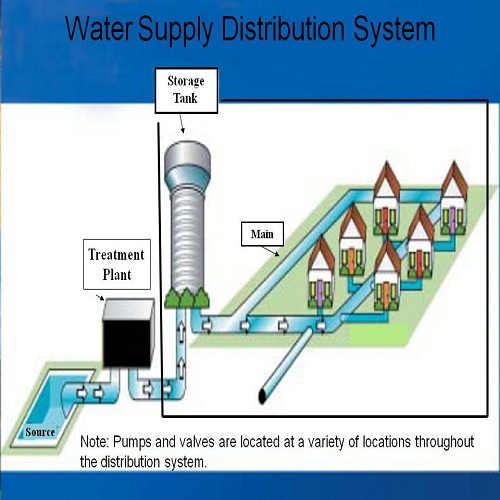
our category
DISTRIBUTION SYSTEM
Distribution System: Efficient and Reliable Delivery of Utilities
Overview:
A distribution system refers to the network of infrastructure, equipment, and processes designed to deliver essential utilities such as water, electricity, gas, and telecommunications from the central source (like a power plant, water treatment facility, or gas distribution center) to the end-user or consumer. The system is integral to ensuring that resources reach homes, businesses, and industrial facilities in a safe, efficient, and controlled manner. A well-designed distribution system is vital for maintaining service reliability, reducing losses, and ensuring that consumers receive uninterrupted utility services.
Enquire Now
Types of Distribution Systems:
-
Water Distribution System: The water distribution system involves the transportation of treated potable water from a water treatment plant to residential, commercial, and industrial consumers. It includes pipelines, pumps, valves, storage tanks, and other components designed to ensure that clean water is delivered at an adequate pressure and flow rate.
Components:
- Pipes/Distribution Mains: Networks of pipes that carry water to end-users.
- Pump Stations: Ensure sufficient pressure and flow throughout the system.
- Valves: Used to regulate, control, and isolate sections of the network.
- Storage Tanks: Provide water storage to ensure a consistent supply.
- Service Connections: The point where the distribution system connects to consumers' premises.
-
Electricity Distribution System: The electricity distribution system delivers electrical power from substations to homes, offices, and industries. This system operates at lower voltages than transmission lines, ensuring that the electrical power is safe for use by consumers. The distribution network typically includes overhead or underground power lines, transformers, and distribution panels.
Components:
- Substations: Step down high-voltage electricity from transmission lines to lower voltages.
- Transformers: Reduce voltage levels for residential and commercial use.
- Circuit Breakers: Protect the system from overloads and faults.
- Distribution Lines: Carry electricity from substations to consumers (either overhead or underground).
- Meters and Panels: Measure electricity usage and distribute power within buildings.
-
Gas Distribution System: A gas distribution system transports natural gas from regional transmission pipelines to homes, businesses, and industrial facilities. It operates at lower pressures and uses a combination of pipelines, regulators, and meters to ensure that gas is delivered safely and efficiently to the end-users.
Components:
- Pipelines: Transport gas to the distribution area.
- Regulators: Control the pressure of the gas to ensure it is delivered safely and efficiently.
- Service Lines: Connect the gas distribution system to the customer's premises.
- Meters: Measure the gas usage of individual consumers.
- Safety Valves: Ensure safety by controlling the flow and pressure of the gas.
-
Telecommunication Distribution System: The telecommunication distribution system connects telecommunication networks (like broadband internet, telephone, and cable TV services) to consumers. It includes both wired (fiber optic, copper) and wireless components that deliver voice, video, and data services.
Components:
- Fiber Optic or Copper Cables: Transmit signals between the service provider and customers.
- Distribution Boxes: House distribution equipment and junctions between cables.
- Switches and Routers: Route and manage data traffic within the network.
- Set-Top Boxes/Modems: Provide interface for consumers to access services.
Key Features and Functions of a Distribution System:
-
Reliability: A distribution system should be reliable, ensuring that utilities are available to customers consistently. Reliability is critical to minimize outages and interruptions. This is achieved by proper system design, regular maintenance, and effective fault detection.
-
Efficiency: Efficiency is a key consideration, as the distribution system must transport resources with minimal loss and wastage. This requires using well-maintained infrastructure and technology that reduces energy loss, minimizes water leakage, and optimizes gas flow.
-
Capacity and Scalability: The system must have the capacity to meet the current demands of users while also being scalable to handle future growth. Properly assessing the demand for utilities is necessary to prevent overloading and ensure future expansion can be accommodated.
-
Safety: Safety is a top priority in all distribution systems, as improper operation or failure can result in hazardous situations. For example, gas leaks, electrical faults, or water contamination can pose significant risks to public health and safety. Distribution systems are equipped with safety valves, circuit breakers, sensors, and emergency response protocols to mitigate such risks.
-
Monitoring and Control: Distribution systems are equipped with monitoring tools that help operators track flow rates, pressures, and system status in real-time. Supervisory Control and Data Acquisition (SCADA) systems are often used to manage large-scale distribution networks and allow for remote control, automation, and rapid responses to faults or issues.
-
Maintenance and Upkeep: A regular maintenance schedule is crucial for the effective operation of the distribution system. Routine inspections, repairs, and upgrades ensure that the infrastructure is in optimal condition and that resources are delivered without interruption.
-
Customer Service: Distribution systems include a customer service component to manage billing, troubleshoot issues, and maintain communication with consumers. Metering systems, customer accounts, and service requests are integral to this aspect of the distribution network.
Challenges in Distribution Systems:
-
Aging Infrastructure: Many distribution systems, especially in older cities or regions, rely on outdated infrastructure that may be prone to leaks, failures, and inefficiencies. Upgrading this infrastructure is often a costly and time-consuming process.
-
Leakage and Losses: Water, gas, and electricity loss due to leakage, inefficiencies, or theft is a common challenge in distribution systems. These losses contribute to higher operational costs and can impact the overall supply.
-
Climate and Environmental Conditions: Weather conditions, such as extreme temperatures, floods, or storms, can damage distribution infrastructure, especially power lines and pipelines. Such events disrupt service and can cause safety hazards.
-
Demand Fluctuations: Distribution systems must cope with fluctuations in demand, such as peak electricity usage during hot summer months or increased water demand during a drought. Managing these peaks is crucial to avoid overloading the system.
-
Regulation and Compliance: Distribution systems are subject to government regulations and standards aimed at protecting public health and safety. Compliance with these regulations, including environmental standards, can require significant investment in system upgrades or maintenance.
Technological Advances in Distribution Systems:
-
Smart Grids: In the electricity sector, smart grids use advanced technology to monitor and control the flow of electricity more effectively. They enable real-time data collection, automated grid control, and faster response to faults, improving system reliability and efficiency.
-
Advanced Metering Infrastructure (AMI): In water, electricity, and gas distribution systems, AMI allows for remote monitoring of consumption, providing customers with detailed usage data and enabling utilities to optimize resource distribution.
-
Leak Detection Technologies: In gas and water distribution systems, technologies such as acoustic sensors and pressure monitoring systems help detect leaks in real-time, allowing for rapid response and reducing losses.
-
Underground Distribution: As urban areas become more congested, underground distribution systems are becoming more common, particularly for electricity and gas. This reduces exposure to weather conditions and makes infrastructure more resilient.
-
Automation and Remote Control: Automation in distribution systems allows for remote monitoring and control, helping to improve operational efficiency, reduce downtime, and enhance system reliability. For example, remote-controlled valves and automatic switches can isolate issues quickly without manual intervention.
Conclusion:
A distribution system plays a critical role in delivering essential services such as water, electricity, gas, and telecommunications to end-users. Whether it's ensuring a constant supply of clean water, providing reliable electricity, or maintaining gas safety, the distribution system is the backbone of modern infrastructure. As demands increase and technology advances, distribution systems are evolving to become more efficient, reliable, and resilient. Addressing challenges like aging infrastructure, demand fluctuations, and climate impacts, while embracing smart technologies, will ensure that distribution systems continue to meet the needs of consumers effectively for years to come.


